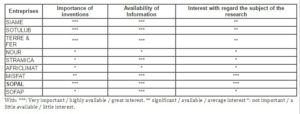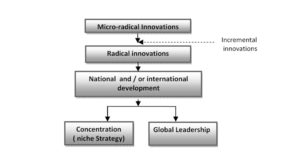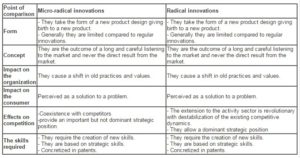Introduction
The acceleration of international trade and the opening of new frontiers have made the international development of SMEs an important issue on both economic as well as managerial level. However, facing these conditions, some SMEs are able to achieve global leadership through a process of development which placed them, primarily, as follower firms, and subsequently creative and leaders. Such is the case of Japanese companies that have astonished the world by outstripping american companies during the 1990s. The work has shown that it is thanks to their strategic intention that the Japanese have created this revolution, which has always been linked to technological radical innovations (Prahalad and Hamel, 1990; Metais, 2002).
Nonetheless, little work has sought to understand the intensity of innovations adopted by SMEs in some emerging countries that were internationalized. This lack of depth in the understanding is consolidated by observation of reality. Indeed, we observe the existence of a number of companies, of these emerging countries, that are able to resist the fierce competition. This is the case of the Tunisian industrial companies. The majority of SMEs are able to grow internationally, especially through exports. Whereas some of these companies are able to differentiate themselves by inventing patented technologies that are commercialized in the foreign market.
This collection of observations leads us to a central question: How to explain the international development of industrial SMEs? We want to know if the technological innovation could be an explanatory factor for the international development of these companies.
The aim of this paper is twofold: we seek, firstly, to understand the intensity of technological innovations adopted by innovative tunisian SMEs that were internationalized and, secondly, explain the development of the latter. To achieve these goals we opted for an abductive approach, favoring a back and forth between the observations gathered from the field and the theoretical knowledge. The empirical field study has been standing during the realization of the research. Whenever a theme is identified in the field, we refer to the theoretical standards which are associated with it for analysis. The two axes that have shaped the theoretical analysis, namely the intensity of innovation and strategic development, were built in parallel with progresses in the analysis of interviews with experts and the study of cases achieved in the field.
So this article is structured as follows: (1) description of the research methodology, (2) the two theoretical axes on which the research is based, (3) the results of the empirical research, (4) conclusions.
Description of the Methodology
To attain its purpose, this research was carried out in three phases which are, a theoretical research, interviews with experts and the case study of a Tunisian industrial company.
Theoretical research:
Within the framework of an abductive approach, it should be noted that theoretical research has been carried out progressively and lasted throughout the research. It will be presented thus the two theoretical axes that guided the latter,which are: the intensity of innovation, the international development of SMEs as well as the link between micro-radical innovations and international development.
Interviews and contacts with experts:
The aim through these interviews is to discuss the explanatory factors for the international development of SMEs in developing countries, while putting in evidence the role of technological innovations. We seek to understand, according to the perception of these experts (managers in Tunisian companies, university professors …), the intensity of patented technologies and their eventual impact on the strategic development of SMEs.
The analysis of these interviews and contacts is made from the technique of thematic content analysis.
Case study:
A – The choice of a case:
In this step, a case study was conducted (Yin, 2002; Rispal Hlady, 2003). This choice is justified on the one hand, by the fact that this company has succeeded to Put its mark on the external market. On the other hand, by the large number of patents, it has deposited in the INNORPI (National Institute of Standards and industrial Property Protection).
Our purpose through the analysis of this case is to appreciate the intensity of technological innovations adopted in this company and to explain its strategic development.
Table 1: The choice of the case

The main criteria for choosing the case are the importance of patents, the availability of the information and the interest with regard to the objective of the research (table 1). Our choice has focused on the production company of brass items “SOPAL”.
B – The analysis strategy:
This was performed by the method of cases and that by choosing a Tunisian industrial SME, in which the study has been tested according to the conceptualization within the first part of this article. It is about a research into the content because the purpose is to study a factor in a static manner while attempting to specify the coexistence of a number of elements that define a particular concept (Thiétart et al., 2003). The analysis tools are essentially: the analysis and the interpretation of speech and the analysis of internal papers. In this context, some directive and semi-structured questionnaires were conducted between March and September 2009 among the executives.
The interviews were then subject to a full transcript processed by thematic content analysis. Throughout the speeches of experts, we have succeeded in identifying various dimensions of technological innovation as well as its intensity.
The constituent elements of a micro-radical innovation are:
– The patent
– The utility of the invention
– The creation of a new competitive space
– The competitive implications
The review of the literature allowed us to identify the determinants of international development, and that by means of the following development pathways: the specialization or the diversification.
The interviews have been suplemented by the analysis of internal company documents, which allowed us to collect as much information as necessary to meet our issues and validate our work.
Several internal documents have been used:
– Brochures and documents exhibiting inventions;
– Documents describing the activities of R & D structures and the designs followed on an international scale.
The Analysis of the Literature
The review of the literature is structured according to three theoretical axes, which are the intensity of innovation, the international development of SMEs, and the relationship between technological innovation and strategic development of SMEs.
It should be noted that the contributions presented here were not defined a priori but in a constant back and forth with the empirical study, and this, because of the abductive nature of our approach.
The intensity of SMEs innovation: micro-radical innovation
Documents dealing with innovation are abundant and can take many forms and can be in varying degrees of more or less important novelty (Durand, 1992; Overdof and Christensen, 2003; Alter, 2004; Prax et al., 2005; Le Loarne and Blanco, 2009; Corbel, 2009). In fact, the innovation may relate to the offering of a product of an organization, its processes, and its working methods. It can be of a technological, commercial, organizational or managerial nature (Barreyres, 1980).
In this work we focus on the technological innovation. This latter can be defined as a process which reflects an effort of R & D more or less important and concretized in a product or a process either new or improved (Le Loarne and Blanco, 2009; Corbel, 2009). It can also take the form of an improved technology launched for the first time in a market where this technology does not exist. In this context, the innovation reflects a novelty not only for business, but also for the market. It differs from the invention, by its utility and its development in the market. Thus we take the following definition as proposed by Zimmern (1973) Which states that an innovation is « the resulting of the complex process of turning the invention into a product or a process which can be industrially and commercially used »(1). This is the definition that will be adopted in the context of this work.
The technological innovation has been discussed in the management documents in three forms: incremental, radical and micro-radical (Durand, 1992; Alter, 2004; Prax et al., 2005; Le Loarne and Blanco, 2009; Corbel, 2009). We refer to these three forms by the concept of innovation intensity. This latter can be defined as the degree of the impact caused by the innovation on strategic positions of companies involved (Durand and Guerra-Vieira, 1998) and, consequently, the impact on the competitive level. This refers to the extent of the radicality of innovation that is appreciated by its novelty and its competitive implications. The intensity is therefore variable. It may be incremental, radical and micro-radical. Whereas the former correspond to some simple improvements in existing technologies, the radical innovations are rather revolutionary and refer to new forms of unprecedented technology (Bellon, 1997; Prax et al., 2005; Le Loarne and Blanco, 2009; Corbel, 2009). Between these two types of innovation, is the micro-radical innovation constituting the focus of this research. This type of innovation seems to be best suited to SMEs, particularly those belonging to countries with limited capacities, developing countries. Indeed, the field study, including interviews with experts, brings up forms of patented and marketed technologies without being widely circulated. The return to the documents leads us to clarify the process in micro-radical innovation.
Early in their development, the radical innovations are classified as micro-radical (Durand, 1992). These latter whilst being « less intense than radical innovations, (…) » are « likely to disturb the competitive dynamics of an industry without thereby jeopardizing the equilibria involved nor the strategic position of established firms »(2). It comes to introduce a radical novelty on the market by providing new solutions to some given problems, whose contribution is limited, although its strategic impact was not very significant (Durand, 1992). It is the technological micro-radical innovation which affects the product as well as the manufacturing process. Unlike the radical innovation that causes a disruption of the competitive dynamics, the micro-radical innovation coexists with current technologies. This is also what Prax et al., (2005) highlight by stating that « the new technology causes (…), not only the disappearance of the former but also a redistribution of territories: each redefines its place, and all stabalize … »(3). This is the case of the movie theaters and video cassettes for example.
In the same perspective, Le Loarne and Blanco (2009) propose another form of innovation destined for markets that are not targeted by dominant firms. These technological innovations are moving away from the area of competitors, but still coexist with the former technologies. Definitely they do not influence in any way the competencies of the competitors, but they do not create a revolution to challenge the old technologies. We believe, in this case, that it is a form of micro-radical rather than radical innovation.
International development and strategic position of SMEs:
The concept of development, as defined in literature, expresses the growth of a company over time. Generally, there are two ways of development: the specialization and the diversification (Martinet, 1983; Strategor, 1993), whose implementation may be carried out by one of the three modes of development, external, internal or joint growth. Thus defined, this concept has been present in the work of Ansoff (1965), which intends to present a growth matrix defined on the basis of product-market relationship. The author identifies four strategies for the company to grow which are : penetration strategy, market expansion, product development and diversification.
Basis on these studies, it is recognized that to grow, the company can choose either the local market, and here we are speaking about the internal development (Yami and Le Roy, 2007), or the external market by relying on different modalities of penetration of foreign markets, such as export (Allali, 2007). These forms of development must have their impact on the strategic positions of the entreprises. On the one hand, and referring to the work of Prahalad and Hamel (1990), the international development of SMEs can help them achieve global leadership. The authors use the example of Japanese companies that were in the 1970s SMEs and now have become leading companies on an international scale. On the other hand, more recent works, related to Allali (2007) and Yami and Le Roy (2007), suggest two alternative forms of development of SMEs based on concentrating on very specific markets. Thus, a company may mark a presence on an international scale without being leader (Allali, 2007), as it can create a single, non-renewable, break allowing it to have an important strategic position in its domain (Yami and Le Roy, 2007).
Whether national or international, the development has always been a primary goal of businesses, particularly SMEs. The field study highlights the role of technological innovation in achieving this goal.
The relationship between radical innovations, development and strategic position: the search for an explanation in the documents
Radical innovations allow their holders to achieve global leadership and thus internationalize (Prahalad and Hamel, 1990; Metais, 2000; Musso et al., 2007). Being less intense than the radical innovations, are those of micro-radical that have necessarily a less important strategic impact. Instead, they allow their holders, to attract certain markets. It comes to adopt niche strategies (Porter, 1990). The development of these innovations requires incremental innovations (Durand, 1992; Creton, 1984 ; Belon, 1997 ; Metais, 2000), which will allow the company to increase its market share and to occupy a position on the international scale.
Empirical Field: Analysis And Discussion
The field research is based on two phases: interviews and contacts with experts and case analysis.
The analysis of interviews and contacts with experts:
These interviews and contacts were carried out with experts in technological innovation and business management. They focused on a discussion about the effort of R & D in Tunisian SMEs as well as the secret of their international development. The analysis of these interviews and contacts was made according to the thematic content analysis technique. The contributions that have been retained and used to explain the development of SMEs and understand the intensity of innovations that they adopt, can be summarized in two basic ideas:
– The existence of new forms of patented and marketed technologies in the local and foreign markets, that go beyond the simple improvements of existing without causing revolutions.
– The importance and the role of these technologies in the development of companies that adopt them.
These two ideas have identified the two thematics thus structuring the revision of the approach.
The analysis of the case:
A – Presentation of SOPAL:
Founded in 1981, SOPAL is an industrial company whose main activity is the production of brass items. The garden taps and the sanitary collectors are the main products manufactured by the company. These products, as shown in Figure 1, hold, respectively, 51% and 24% of total turnover.

Source: Internal document SOPAL.
Fig 1: Distribution of the turnover by product in 2012
B – R & D effort and micro-radical innovation:
Following the VALEO model, including the practice of « simultaneous engineering » the effort of SOPAL’s R & D is important. Indeed, this model consists of working in groups, by involving all functions of the enterprise, allowing to create new ideas and innovate while avoiding the risk of failure of innovations. The importance of the effort of R&D, in this company ,is valued by the large number of invention patents which, while being marketed, take the form of technological innovations (Zimmern, 1972). Indeed, having a « development and industrialization » department, the company recorded a large number of invention patents. These inventions were marketed in the local and the external market. This is how they get the form of technological innovations. The latter are the the realization of key skills, but their introduction into the market has not challenged the competing technologies. They are thus classified as micro-radical innovations. Such as the « anti-fraud system » which represents an example of this type of innovation, that characterize the technological effort of SOPAL. Building on the model of Kim and Mauborgne (2003), this innovation has the following advantages:

Diag 1: Example of competitive space created by SOPAL
• Adding a KFS: a control system
The technical feature of this technology is to block the threaded nut under the counter when operated in the opening direction in order to the fight against fraud. This technology is very useful especially for the National Society of Exploitation and Distribution of Water.
• Deleting a KFS: sales promotion
If the sales promotion can be a distinct advantage, it was not considered as KFS. The company was limited to advertising as a means of communication.
• Radical increase of KFS: Quality
SOPAL has managed to offer a Tunisian product with a quality equal to that of import competing products.
• Radical decrease of KFS: price
If the import competing products have the disadvantage of being expensive, SOPAL has managed to produce a product with the lowest cost. Being of good quality, this product is at value for money acceptable.
Being marketed nationally and internationally (Morocco, Libya and Algeria), the anti-fraud system gives an example of a technological micro-radical innovation. It opens a new market, it creates value, but it has not challenged the competing technologies. It co-exists with these technologies, and it is still in development.
C – International development through exportation:
The micro-radical innovations constitute the type of innovation characterizing the efforts of SOPAL’s
R & D department and relates to the main activities of the company, which are the taps and the sanitary collectors. These activities represent respectively 51% and 24% of the total turnover of the company. Adding to that 50% of this turnover comes from outside, particularly the marketing of sanitary collectors and taps to Morocco, Libya and Algeria. Exporting is so, the path of penetration of foreign markets.
D – SOPAL position in foreign markets:
By exporting new technologies to the Maghreb countries, the company manages to make its presence internationally and becomes able to challenge its competitors especially being distinguished by a sustainable competitive advantage. Its core competencies reside in invention patents that it has registered since 2000.
On the Tunisian market, SOPAL occupies a leadership position.
Synthesis on the relation micro-radical innovations and international development : a proposal for an explanatory diagram.
The case of SOPAL illustrates how a SME has been internationalized via exportation. The efforts of R & D represents a strategic lever that allows the company to build core competencies. The latter are concretized in micro-radical innovations which, although still in the process of development, allow the company to attract some international markets or even to adopt niche strategies. On the local market SOPAL occupies a leading position.
The relationship, which appears between the micro-radical innovation and the strategic development of a SME, is summarized in the diagram below:
 Diag. 2: Explanatory diagram of the strategic development of SMEs: illustration by the case studied
Diag. 2: Explanatory diagram of the strategic development of SMEs: illustration by the case studied
Back to the literature:
The case analysis of SOPAL brings up links between the intensity of technological innovation and strategic development. This deserves to be argued with literature concerning the position and therefore show our contributions in relation to this theory. On the one hand, it appears from the analysis of the case that the SME adopting micro-radical innovations can develop on the national and / or international scale.
This relationship has a certain deviation from the literature which assumes that SMEs, adopting radical innovations, internationalize (Prahalad and Hamel, 1990; Metais, 2002). On the other hand, the case of SOPAL shows that a SME grows internationally by adopting niche strategies. This relationship represents a certain deviation from the theory which still assumes that SMEs internationalize by occupying an important strategic position or global leadership (Prahalad and Hamel, 1990; Metais, 2002). But it confirms the approach of Allali (2007) to whom, a SME can be present on foreign markets without being leader. Finally, it still seems that micro-radical innovations require incremental innovations to increase their micro-radical innovations development. This relationship joins the literature which assumes that: Being in development, the radical innovations are considered as micro-radical and require incremental innovations to increase their development (Durand, 1992; Creton 1984 ; Belon, 1997 ; Metais, 2000).
Finally, this study of confrontation with the existing literature, allows us to summarize the different works and thus clasify the field results relative to these writings, through the schematization 3.

Diag. 3: Confrontation with the literature: synthesis on the relation between micro-radical innovations and international development of SMEs
Conclusion
The detailed case study of a Tunisian industrial SME has led us to the conclusion that it is possible for a SME from an emerging country to internationalize creating niches in foreign markets. Our research suggests that the way of penetration to these markets is the export of new technologies. The latter take the form of micro-radical innovations and allow their holders to have a continuous development by providing a sustainable competitive advantage. These innovations are complemented by incremental innovations that guarantee their sustainability in the market and ensure their development.
This article offers several, theoretical, and managerial contributions. First, we propose a more operational definition of micro-radical innovation, which helps to reinforce the robustness of the conceptual framework. In addition, the explanations that we have presented allow a better understanding of authors’ reviews who were till then seem divergent. These contributions help to clarify the conceptual basis of the micro-radical innovation. Furthermore, this research allows to emphasize the consequences of the micro-radical innovation for managers in their companies. If the new economic model focuses on a niche or creates a new market, it will be able to coexist with the existing economic model (although this coexistence leads to management difficulties). Similarly, showing that the micro-radical innovation is open to existing entreprises, we encourage SMEs, especially in emerging countries to internationalize. In this sense, this study helps to explain the concept of micro-radical innovation, for both researchers and managers.
A significant limitation of our study stems from the methodology used: of an exploratory nature, it only allows to suggest, not to confirm, explanations. Indeed, even if one of the originalities of our work is based on a qualitative approach combined with an original case, this methodology rejects generalization.
Much research is therefore still be needed to consolidate the concept of micro-radical innovation and clarify its importance for SMEs in developing countries. They constitute so many exciting prospects for research, useful for both researchers and practitioners confronted with a highly competitive environment.
Notes:
(1) Zimmern, B. (1972) De l’invention à l’innovation, Management- France, p 11.
(2) Durand, Th. and Guerra-Vieira, S. (1998), « Etalonner l’innovation: métrique d’une innovation annoncée », 7ème conférence de l’Association Internationale du Management Stratégique (AIMS), 27 – 29 Mai, Louvain La Neuve, p 3.
(3) Prax, J- Y, Buisson, B. and Silberzahn, Ph. (2005), Objectif : innovation- stratégie pour construire l’entreprise innovante, Dunod, p 56.
(adsbygoogle = window.adsbygoogle || []).push({});
References
Allali, B. (2007) ‘Vision et turbulence dans les PME qui s’internationalisent’, Management international, 11 (2), 41-52.
Ansoff, I. (1967) Stratégie de développement de l’entreprise, Dunod.
Barreyre, P-Y. (1980) ‘Typologie des innovations’, Revue Française de Gestion, 3 (24), 9-15.
Bellon, B. (1997) L’innovation créatrice, Economica.
Boldrini, J. C. (2008) ‘Caractériser les pratiques de conception des PME pour mieux accompagner leurs projets d’innovation’, Revue internationale PME, 21 (1), 9-34.
Google Scholar
Corbel, P. (2009) Technologie innovation stratégie, Gualino éditeur.
Durand, Th. (1991) ‘Dual technological trees: Assessing the intensity and strategic significance of technological change’, Research policy, 4 (21), 361-380.
Durand, Th. and Guerra-Vieira, S. (1998), ‘Etalonner l’innovation: métrique d’une innovation annoncée’, 7ème conférence de l’Association Internationale du Management Stratégique (AIMS), 27 – 29 Mai, Louvain La Neuve.
Gavard- Perret, M-L., Gotteland, D. Haon, Ch and Jolibert, A. (2008), Méthodologie de la recherche- réussir son mémoire ou sa thèse en sciences de gestion, Person Education France.
Gueguen, G. (2009) ‘PME et stratégie : quelles spécificités ?’, Economie et Management, 4 (131), 16-22
Hamel, G. and Prahalad, CK. (1990), ‘Les stratèges du soleil levant’, Harvard l’Expansion, 6 (3), 6-19.
Hlady Rispal, M. (2002) La méthode des cas – application à la recherche en gestion -, De Boeck & Lacier s.a.
Google Scholar
Kim, W. Ch. et Mauborgne, R. (2003), Créer un nouvel espace de marché, in, l’innovation, Editions d’organisation.
Le Loarne, S. and Banco, S. (2009) Management de l’innovation, Pearson Education France.
Martinet, A. Ch (1983) L’entreprise dans un monde en changement, Seuil.
Métais, E. (2002) ‘Vers la notion de polyvalence stratégique’, Revue Française de Gestion ,28 (138), 33-48.
Musso, P., Ponthou, L. and Seuillet, E. (2007) Fabriquer le futur 2 – l’imaginaire au service de l‘innovation, Village Mondial.
Prahalad, C.K. and Hamel, G. (1990), ‘The core competence of the corporation’, Harvard Business Review, 68 (3), 79-91.
Prax, J- Y, Buisson, B. and Silberzahn, Ph. (2005), Objectif : innovation- stratégie pour construire l’entreprise innovante, Dunod.
Schumpeter, J. (1990) Capitalisme, socialisme et démocratie, Edition Bibliothèque Historique Payot.
Strategor (1993) Stratégie, Structure, Décision, Identité, Inter éditions.
Yami, S. and Le Roy, F. (2007), ‘Les stratégies de rupture en PME: une étude de cas’, Management international, 11 (2), 1-13.
Yin, RK. (1991) Case strategy research: design and methods, Sage publications, Newbery Park, CA.
Zimmern, B. (1972) De l’invention à l’innovation, Management- France.
Appendix 1: The distinctive characteristics of innovation according to its intensity

Appendix 2: Fact Sheet for SOPAL

Source: Internal document SOPAL.










